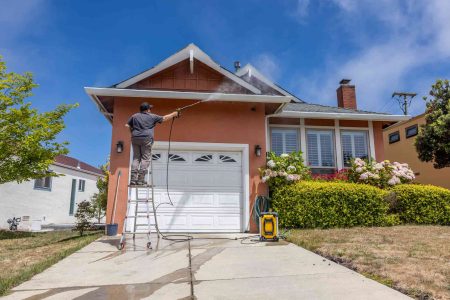For many homes, outdoor lighting is limited to a front door light and maybe one in the back. While that’s a good start, a well-designed DIY landscape lighting system opens up a universe of possibilities.
Landscape lighting adds personal safety for walking and it increases home security. Plus, path lights, spots, and floods are a creative expression to inspire visitors, and they set an enchanting mood at night.
What to Consider Before Installing Landscape Lighting
Before installing landscape lighting, decide on which of the three main types of landscape lighting is best for your home: solar lighting, low voltage lighting, or line voltage lighting. Install any one of these systems by itself or combine them as needed.
Solar Landscape Lighting
-
Rechargeable
-
Placeable anywhere
-
Inexpensive
-
Sunny areas only
-
Fade out at night
-
Dim lights
Individual solar landscape lights have small built-in solar panels to capture light, tiny photocells to sense darkness, and batteries to retain the charge for a number of hours.
As an alternative, multiple (usually five to seven) solar lights can share a single solar panel. While the lights must be wired into the solar panel, the connected series as a whole can be placed anywhere, as long as the panel has sun coverage.
Solar landscape lights are perfect for defining the outlines of a path or driveway. Solar lights have no wires tethering them to the house. So, combined with a wired landscaping lighting system, they can extend the overall network to the most remote parts of the property.
Ranging from 10 to 55 lumens, solar landscape lights are dimmer than other landscape lights (compare to the 92 lumens output of a 30-watt low voltage system bulb).
Solar landscape lights need to be placed advantageously so that they receive the most amount of sun. This usually eliminates places like under shade trees or in dark side yards. Solar lights start strong but fade through the night. By dawn, the light is usually gone.
Low Voltage Landscape Lighting
-
Consistent light
-
Timer scheduling
-
Moveable
-
Light connections balky
-
Cable length limit
-
Light limits per cable
Low voltage landscape lights receive power from a transformer plugged into an outdoor GFCI outlet. The transformer steps down the power from 120V to 12V or 24 V.
Wired into the transformer is a 50- to 75-foot black or dark-colored cable that extends throughout the yard. Lights can be attached to the cable at any point with a push-pierce style connector that safely pieces the sheathing and touches the copper wire inside.
Low voltage landscape lights are safe to install, as well as safe to use and maintain. With timers built into the transformers, they are energy efficient. The lights remain on for as long as you schedule them, with no fade-out. Since the cable can run on top of the ground or be buried at just a few inches, low voltage lights are simple and easy to move.
But the electrical connections afforded by the push-pierce devices can be tenuous. Often, they might work for a while, only to fail a couple of seasons later. Cables limit how far the lights can extend on the property. The number of lights per single cable is not determined by voltage but rather by wattage on the terminal. The cable length used to greatly effect the brightness of the lights, with lights closer to the transformer being much brighter than the far end of the cable, however with LED lights this is no longer an issue. The light either works or the voltage drops below the required limit and the light stops working.
Line Voltage Landscape Lighting
-
Higher power
-
Brighter light
-
Protected cable
-
More difficult to install
-
Separate materials, no kit
-
Hard to move or alter
Line voltage landscape lights, sometimes called 120V lights, begin with 120V power just like the low voltage light systems do. But instead of stepping down the voltage, 120V continues all the way through the deeply buried cable.
Line voltage landscape lights provide a consistent light that’s brighter than low voltage lights. For spotlighting large areas or running many path lights, line voltage is a better option than low voltage.
Made of heavy-duty metal, line voltage lights tend to be more robust and last longer than plastic low voltage lights. The lights are overall brighter, there is less chance of failure, and you can even add extras like intermittent GFCI outlets.
The electrical cable is well protected and out of the way. If direct burial, the wire is required to be at least 24 inches deep; if using a PVC conduit, it is required to be at least 18 inches deep. But if the cable does happen to become compromised—for example, if you use direct burial UF wire instead of conduit and the wire is pierced—it will be a safety hazard due to the higher voltage. Once installed, line voltage landscape lighting is considered to be permanent: trench depth and conduit make the system difficult to move.
When to Install Landscape Lighting
Install DIY landscape lighting at any time of year when the ground is dry, clean, and clear of obstructions like snow, ice, leaves, or debris.
Many solar light systems need a full day of sunlight to establish a strong, initial charge. Because of this, they should be installed in spring or summer and early in the day.
For line voltage landscape lighting, frozen ground may make it difficult or impossible to dig trenches for the electric cable. For all types of landscape lighting, metal or plastic stakes must be driven into the ground for mounting the lights. Aluminum or plastic stakes may bend or break when pounded into frozen ground.
Designing Landscape Lighting
Pathway landscape lights are commonly installed outdoors to illuminate and draw crisp outlines next to pathways, around lawn or garden perimeters, around garden water features, and along outdoor stairs.
Spotlight landscape lights are flexible, and a host of light design techniques let you set the right mood:
- Highlighting: Use the spotlight to feature a fountain, rock cluster, a plant, or anything else that’s noteworthy.
- Silhouetting: Place the spotlight behind a feature and point the light toward the viewer. Keep the light close to the feature or tilt it up to avoid shining the light in the eyes.
- Shadowing: Let long grass, palms, or hosta shadows dance across the side of the house, a wall, or a fence by pointing a spotlight upward at the feature.
- Washing: Light washing works best with flat objects like walls, house siding, or sculptured topiary. The spotlight is positioned at a low angle to the feature, raking it with sharp shadows.
- Moonlighting: Landscape lighting doesn’t always belong on the ground. Attach the light to a high place like a tree branch to cast a mysterious, soft moon-like glow on paths and foliage.
Choose the Best Location For Landscape Lighting
- Find a power source: Solar lights have their own power source. But low voltage landscape lights should stay near an outdoor GFCI outlet. The transformer cord is usually about 6 feet long. For line voltage lights, a new power source will be established on the side of the house.
- Install lights on firm but soft ground: Landscape lights are staked in place with PVC or metal stakes from 6 to 13 inches long. Stakes will not penetrate hard, compact soil. The soil should be firm but soft enough for the stakes to penetrate.
- Locate the transformer or solar panel: For low voltage lights, position the transformer near the GFCI outlet. For solar lights, find a place where the solar panel will receive direct sunlight. Avoid artificial lights that may interfere with the panel.
Landscape Lighting Codes and Regulations
Permits
Generally, an electrical permit will not be required for solar landscape lighting or for low voltage lighting with an existing 120V GFCI outlet that’s up to code, including a waterproof outlet cover.
If there is no outdoor outlet, one must be installed and it must be permitted. Line voltage landscape lighting usually will require a permit.
Regulations
Some communities regulate exterior lighting. The purpose is to limit the negative impact of landscape and other exterior lighting on off-site areas. Glare and light trespass that spill onto neighboring properties can be a nuisance. If the light extends to the roadway, it can be a hazard.
Dark-sky initiatives aimed at reducing overall light pollution may also be included in local ordinances. Since these ordinances often include residential DIY landscape lighting, check your municipal code or ask your local permitting office for clarification.
Safety Considerations
When digging at any depth, it is always a good idea to call your area’s one-number locator service (usually 811), a statewide toll-free telephone number where you can request a location technician to visit your property.
In some areas, you might even be legally required to call the locator service for any excavation on private, non-commercial property at or below a certain depth (12 inches, for example). Landscape light stakes can extend as far as 13 inches below ground level.
What You’ll Need
Equipment / Tools
Solar or Low Voltage Landscape Lighting
- Phillips screwdriver
- Mallet
- Tape measure
- Trenching shovel
Line Voltage Landscape Lighting
- Fish tape
- Pliers
- Wire stripper
- Hacksaw
- Drill
- Auger bits, set
- Shovel
Materials
Solar or Low Voltage Landscape Lighting
- Remote panel solar landscape lighting kit
- Low voltage landscape lighting kit
- Electrical tape
Line Voltage Landscape Lighting
- PVC or metal conduit
- UF 14/2 wire or individual wires
- 90-degree conduit bends
- Waterproof subpanel or L-body Conduit Fitting
- Four-by-fours
- 24-inch fence spikes
- FSC outdoor-rated boxes
- Outdoor light fixtures
Instructions
How to Install Solar Landscape Lighting
-
Select General Location
Find a location that will allow you to place the solar panel so it is facing direct sunlight for six to eight hours a day. The solar panel should not be facing a streetlight or other constant light as this will prevent the automatic lights from turning on. With most systems, there is a long cable lead between lights—at least 10 to 20 feet.
-
Insert Batteries
Unless your system has non-removable batteries, you may need to insert rechargeable batteries. Use the batteries that come with the system or purchase batteries specified by the manufacturer. Use a small manual Phillips screwdriver to remove the waterproof battery cover. Place the batteries in the correct directions. Replace the battery cover, turning the screws firmly to prevent water intrusion.
-
Install Solar Panel
Within the chosen general location, find a spot for the solar panel so it will receive the most amount of sunlight. With many remote panel systems, the last light in the series is the one that connects to the solar panel. So, keep this in mind when establishing its location.
Tap the stake into the ground. Insert the riser post into the stake. Insert the solar panel onto the top of the riser post. Tilt the panel in the direction of the sun.
-
Install Lights
With the tape measure, measure out the distance you desire between each light. The distance can range from as little as 2 or 3 feet apart up to the entire cable length between lights (minus 2 feet to allow for hookups).
Install each light as you did the solar panel. Drive the stake into firm ground, insert the riser post, then finish by placing the light on top of the riser post.
-
Connect Lights
Solar lights have different ways of connecting to each other. In one common setup, each light has a long cable and a short cable. The long cable extends to the next light in the series. At that next light, the long cable attaches to the short cable. Plug in the connections firmly.
-
Connect Cable to Solar Panel
Attach the last solar light to the solar panel or otherwise as directed by the instructions.
-
Activate System
Turn on the system and let the batteries charge for 6 to 8 hours.
Solar Landscape Lighting Tips
- Rechargeable batteries do have a lifespan, so look for systems with replaceable batteries.
- Keep the solar panel clean by wiping it with mild detergent and water.
- Bundle loose wire with hook-and-loop straps instead of rubber bands, which quickly become brittle when exposed to the elements.
How to Install Low Voltage Landscape Lighting
-
Lay Out Cable and Lights
Unspool the low voltage cable along the general route the lights will take. Place fixtures near the spots where you intend to stake them. Make sure to leave enough cable to reach the transformer (which will be near the GFCI outlet), plus another 3 or 4 feet to give yourself enough cable to work with. Keep the first light within 10 feet of the transformer.
-
Dig Trench
With the trenching shovel, dig a trench 3 inches deep. Keep the soil and sod as intact as possible as you lay them on plastic sheeting next to the trench.
-
Lay Cable
Place the cable in the trench. Be careful to avoid soil falling onto the cable for now.
-
Install Transformer
Locate the transformer no more than 6 feet from a GFCI exterior outlet and at least 20 inches above ground level. Attach the transformer directly to the side of the house. With vinyl siding, it’s best to first add a 1/2-inch plywood mounting board, then attach the transformer to the mounting board.
-
Add Stakes
Pound stakes into the ground at the intended locations. Do not install the lights on the stakes yet.
-
Connect Lights to Cable
Push the two separate sides of the push-pierce connector together, trapping the cable between the two as you push. Each spike on the connector must pierce the cable sheathing and contact the inner copper wire. Push the two halves together as tightly as you can by hand (do not use pliers).
-
Place Lights on Stakes
Push the light onto the stake. Step back and check for plumb.
-
Attach Cable to Transformer
Use the wire stripper to strip and separate the two wires at the transformer end of the cable. Loosen the screws on the transformer terminals. Hook the wires over the terminal screws, then screw tightly into place.
Warning
Low voltage only means that electricity in the buried cable run is low voltage. All voltage running to the transformer and within the transformer is still high voltage.
-
Test System
Plug the transformer into the outlet. Switch the transformer to manual operation and make sure that all lights are working.
-
Bury Cable
With the lights still on, bury the cable. If any lights stop working as you replace the soil, the connection is loose and needs to be adjusted or reconnected.
Low Voltage Landscape Lighting Tips
- Clean the cable before attaching the push-pierce connector. This ensures a better connection.
- Don’t leave open holes on the cable if you need to move the light. Instead, cover the holes tightly with electrical tape.
- Lights toward the end of long cable runs can be dimmer than lights closer to the transformer. Use a maximum of 100 feet for every 100 watts of light.
How to Install Line Voltage Landscape Lighting
The following guide is an overview of the basic process that might be undertaken by an electrician or an experienced do-it-yourselfer when installing 120V landscape lighting.
-
Drill Hole on Side of House
With an auger bit, drill a hole in the side of the house near the electric service panel.
-
Attach Outdoor Subpanel or L-body Conduit Fitting
- Subpanel: The home’s main, indoor electric service panel can feed into a waterproof outdoor subpanel with four to eight spaces for circuit breakers; or
- L-body Conduit Fitting: If running just one line, use an L-body conduit fitting. This L-shaped box brings a wire out of the house and then turns it 90 degrees to head into the ground.
-
Dig Trench
Dig the trench to 6 to 18 inches deep if using conduit or 24 inches if using UF outdoor direct burial wire.
-
Create Light Mounting Posts
The type of light you choose dictates how it is mounted. One method is to install a short four-by-four post per light that will carry all of the needed items: lights, conduit, and junction boxes. Plus, it is a solid base if you decide to add an auxiliary GFCI outlet.
Run the conduit up from the ground to an FSC (Field Service Continuous) outdoor-rated box of the size and shape required for the light.
-
Run Conduit or UF Wire
- Conduit: Add 1/2-inch PVC conduit to the trench. Add 90-degree PVC conduit bends as needed to bring the wire up to individual lights; or
- UF wire: Run UF outdoor direct burial wire. Protective conduit is required for all bends that send the wire up or back into the ground. UF wire should never be left exposed.
-
Fish Wires Through Conduit
If using conduit, run a fish tape through the conduit, from one opening to the next available opening. Attach the 14 wires (individual wires, not cable) to the end of the fish tape, then pull it through the conduit. Leave plenty of extra wire length at each end to work with.
-
Attach Lights to Boxes
Wire the outdoor lights at each location and tightly screw them into place on the boxes.
-
Cover Trench
If you are satisfied that the all lights are working properly, cover up the trench.
Line Voltage Landscape Lighting Tips
- While not essential to run a single 120V line, a subpanel provides you with exterior-based control over the lighting system, plus it expands the potential reach of the system.
- Use a 24-inch fence post ground spike for the four-by-four. This establishes a thinner profile within the ground for conduit 90-degree bends than a thicker concrete-and-gravel base.
- With outdoor electrical boxes, look for a box with two through-ports on one side. When mounted, the ports will be on the bottom of the box to accommodate incoming and outgoing conduit. Avoid boxes with extra ports, as they would need to be capped for weatherproofing.
When to Call a Professional
Line voltage landscape lighting is usually installed by a qualified licensed electrician or by a highly experienced do-it-yourselfer. Unlike low voltage lighting kits, unified 120V landscape light kits are rarely available. Instead, you’ll need to create a plan and then assemble components one by one. This is the type of guidance and experience that a qualified electrician can help with.
Read the full article here














